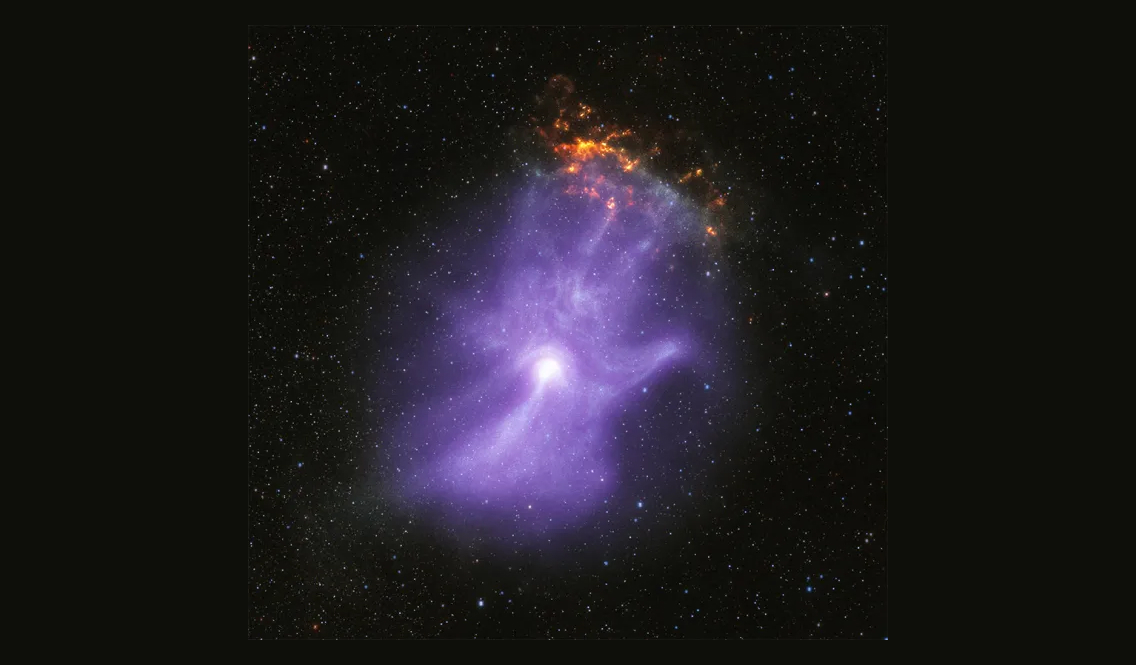Ghostly Cosmic Hand Unveiled by NASA's X-ray Telescopes

October 30, 2023
This article has been evaluated according to the editorial process and guidelines of Science X. The editors have verified the following aspects to ensure the credibility of the content:
- fact-checked
- peer-reviewed publication
- trusted source
- proofread
by Beth Ridgeway, NASA
In 1895, Wilhelm Röntgen discovered X-rays and utilized them to create an image of the bones in his wife's hand, marking the advent of a significant diagnostic tool in medicine. Recently, two of NASA's X-ray space telescopes have amalgamated their imaging capabilities to lay bare the magnetic 'bones' of an extraordinary hand-shaped structure in space. These telescopes expose the activities of a dead star that collapsed but continues to exist via energized matter and antimatter plumes.
About 1,500 years back, a giant star in our galaxy exhausted its nuclear fuel, consequently it collapsed inwards, resulting in an extremely dense entity known as a neutron star.
Neutron stars with robust magnetic fields and rotation, known as pulsars, act as extreme physics laboratories, exhibiting conditions that can't be reproduced on Earth. Young pulsars generate matter and antimatter jets that move away from the pulsar's poles, accompanied by a strong wind, thus forming a 'pulsar wind nebula.'
In 2001, NASA's Chandra X-ray Observatory initially observed the pulsar PSR B1509-58. The study showed that its pulsar wind nebula (MSH 15-52) mirrors a human hand. The pulsar is positioned at the base of the nebula's 'palm'. MSH 15-52 is about 16,000 light-years distant from Earth.
Recently, NASA's newest X-ray telescope, the Imaging X-ray Polarimetry Explorer (IXPE), monitored MSH 15-52 for around 17 days - the longest observation period for any single object since its launch in December 2021.
'The data from IXPE provides us with the initial map of the 'hand's' magnetic field,' stated Roger Romani of Stanford University in California, the study's leader. 'The X-rays-emitting charged particles follow the magnetic field, critically shaping the nebula's basic form, similar to how the human hand is shaped by bones. Credit: NASA
IXPE offers details about the X-ray source's magnetic field-determined electric field orientation, known as X-ray polarization. In vast areas of MSH 15-52, the polarization volume is notably high, reaching the peak level predicted from theoretical studies. To attain this intensity, the magnetic field needs to be exceptionally straight and consistent, indicating minimal turbulence in these pulsar wind nebula regions.
'X-rays are typically known for their medical diagnostic utility in humans,' stated study co-author Josephine Wong, also from Stanford. 'In this scenario, we are using X-rays differently, but they are still unveiling information that would otherwise remain hidden to us.'
A striking attribute of MSH 15-52 is a bright X-ray jet emerging from the pulsar to the 'wrist' at the image bottom. The fresh data from IXPE shows that initial jet polarization is low, probably due to the region's turbulence and complex, tangled magnetic fields linked with high-energy particle creation. Towards the end of the jet, the magnetic field lines seem to become more regular and uniform, leading to considerably greater polarization.
This implies that particles receive an energy boost from complex turbulent regions near the pulsar (at the palm base), flowing to areas where the magnetic field is uniform along the wrist, fingers, and thumb.
'We've discovered the life cycle of exceedingly energetic matter and antimatter particles surrounding the pulsar,' said study co-author Niccolò Di Lalla, from Stanford. 'This helps us understand the function of pulsars as particle accelerators.'
IXPE has also identified similar magnetic fields in the Vela and Crab pulsar wind nebulae, suggesting that these may be quite common in such objects.
The results have been published in a new paper in The Astrophysical Journal.
Journal information provided by: The Astrophysical Journal
Provided by: NASA




